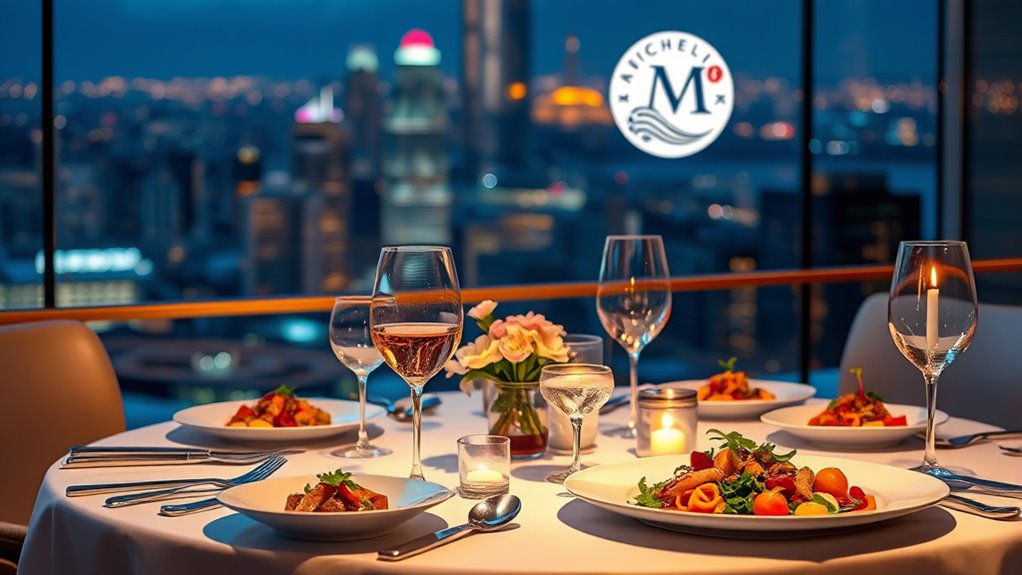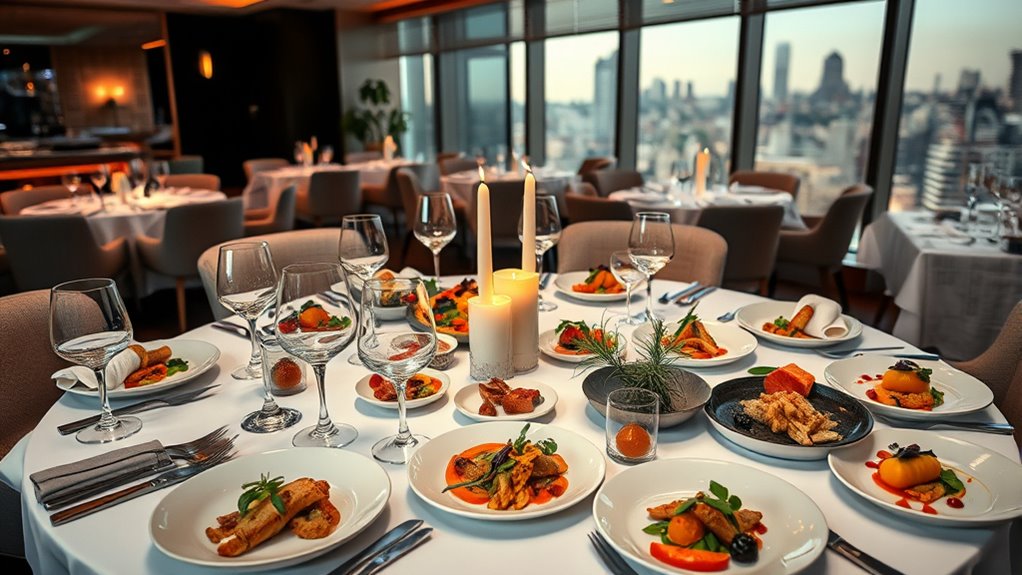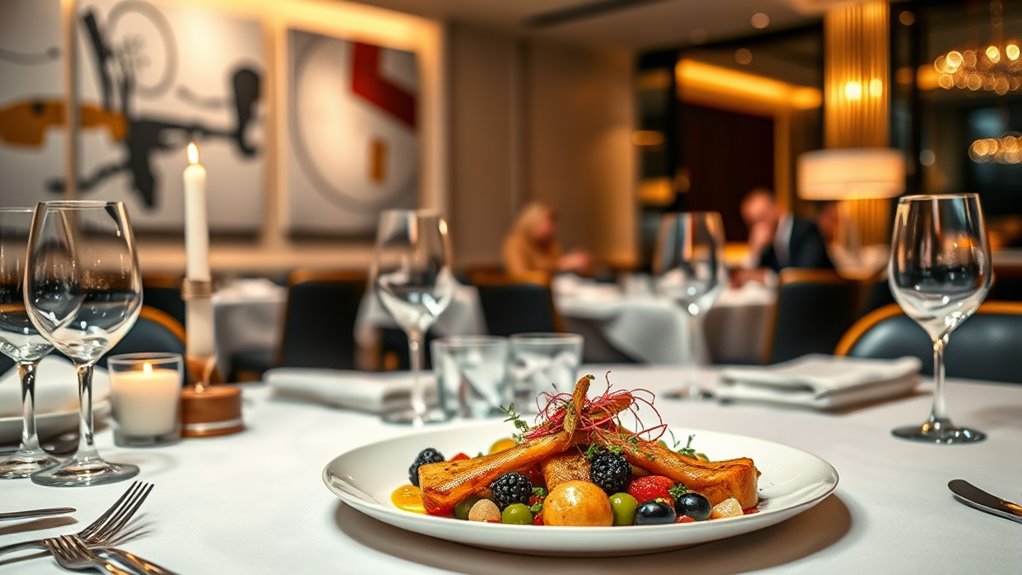Dining at Michelin-starred restaurants takes you on a remarkable culinary adventure. Each establishment showcases exceptional flavors and innovative dishes crafted by skilled chefs. Countries like France, Italy, and Japan boast the highest number of these prestigious restaurants, with many offering a truly unique experience. Michelin stars not only enhance a restaurant’s reputation but also boost local tourism and culinary trends. Discover the stories behind these acclaimed venues and the inspiration that fuels their artistry.
Key Takeaways
- Michelin-starred restaurants symbolize culinary excellence, attracting food enthusiasts to dine at renowned establishments worldwide.
- France leads globally with 660 Michelin-starred restaurants, showcasing its rich culinary heritage and innovation.
- The elite three-star Michelin restaurants, totaling 146, represent the pinnacle of gastronomy and are found primarily in France, Japan, and Italy.
- Dining at Michelin-starred venues often results in a unique culinary experience, with chefs showcasing mastery in flavor and technique.
- Earning a Michelin star can significantly boost a restaurant’s revenue and influence culinary trends, attracting a diverse clientele.
The Prestige of Michelin Stars

The allure of Michelin stars captivates food lovers and chefs alike. When you dine at a Michelin-starred restaurant, you’re experiencing culinary excellence defined by strict criteria. Inspectors assess everything from the quality of ingredients to a chef’s mastery of flavors, ensuring each dish harmonizes beautifully. Earning a Michelin star elevates a restaurant’s prestige, attracting diners from around the globe and increasing demand for reservations. One star signifies a very good restaurant, while three stars indicate exceptional cuisine worth a special journey. This recognition not only boosts revenue but also opens doors to major culinary events. Ultimately, Michelin stars set a benchmark for quality, inspiring chefs and enhancing your dining experience with innovative and creative dishes. MICHELIN Stars signify the highest level of culinary excellence, making them a globally recognized symbol of fine dining.
Countries Leading in Michelin-Starred Restaurants

Michelin stars don’t just signify culinary excellence; they highlight the countries that excel in fine dining. France leads the pack with an impressive 660 Michelin-starred restaurants, showcasing its rich culinary heritage.
Following closely, Italy boasts 401, while Japan ranks third with 396. Germany and Spain round out the top five, with 353 and 274 starred establishments, respectively.
Notably, France has seen a 19% growth in its Michelin offerings from 2023 to 2024, emphasizing its ongoing dominance. Italy and Japan also experienced notable increases, at 10% and nearly 15%.
As Michelin stars spread across 37 countries, the culinary landscape continues to evolve globally, making it an exciting time for food enthusiasts everywhere.
Understanding Michelin Star Ratings

When it comes to fine dining, understanding Michelin star ratings can elevate your culinary experiences. The Michelin Guide began as a tire marketing tool in 1900, evolving to include restaurant reviews by 1926. The star system emerged shortly after, with one star introduced in 1926, followed by two and three stars in subsequent years.
Understanding Michelin star ratings can enhance your fine dining adventures, reflecting a rich history of culinary excellence.
Today, it covers 37 countries, recognizing exceptional culinary achievements.
Michelin stars are awarded based on criteria like the quality of ingredients, mastery of cooking techniques, and the chef’s personality. Consistency across the menu is crucial, and inspectors visit anonymously multiple times to ensure fair assessments.
Restaurants can earn one, two, or three stars, each representing varying levels of culinary excellence worth your attention.
The Elite Three-Star Michelin Restaurants

Achieving three stars in the Michelin Guide sets a restaurant apart as a pinnacle of culinary excellence, attracting food enthusiasts and travelers alike. With 146 three-star establishments globally, France, Japan, and Italy lead the way.
In the U.S., California and New York boast multiple top-rated venues, including Thomas Keller’s The French Laundry and Per Se. Japan shines with its renowned sushi omakase at Masa, while Corey Lee’s Benu combines French techniques with Asian flavors.
To earn three stars, restaurants must excel in ingredient quality, technique mastery, and consistent dining experiences. Each menu features innovative dishes, like Eleven Madison Park’s seasonal vegan offerings and Atelier Crenn’s artistic cuisine, ensuring an unforgettable experience that keeps diners coming back.
The Economic and Cultural Impact of Michelin Stars

Earning a Michelin star can significantly transform a restaurant’s economic landscape and cultural footprint.
You’ll likely notice a surge in business, often referred to as the “Michelin bump,” leading to higher revenues. However, restaurants may also raise prices—sometimes by 15% for one star or over 80% for three stars.
While increased revenue can enhance local tourism, the pressure to maintain Michelin standards can strain resources and create operational challenges.
Culturally, Michelin stars set a benchmark for excellence, influencing culinary trends and innovation.
Working in these establishments is a prestigious milestone for chefs. Yet, the influx of new patrons may alter customer dynamics, potentially alienating regulars and elevating expectations that, if unmet, could lead to negative reviews.
Frequently Asked Questions
How Are Michelin Inspectors Selected and Trained?
Michelin inspectors are selected based on their extensive experience in the food industry, often requiring at least five years.
They need expertise in international ingredients and culinary techniques.
Once selected, you’ll undergo a rigorous training process, accompanying seasoned inspectors for up to a year.
During this time, you’ll learn the five evaluation criteria and familiarize yourself with global cuisines, ensuring you maintain the high standards expected of Michelin’s assessments.
Can Restaurants Apply for Michelin Stars?
You can’t apply for a Michelin Star; instead, inspectors review restaurants based on their reputation and customer feedback.
They evaluate various aspects, such as the quality of ingredients and cooking techniques, through anonymous visits.
It’s all about consistently delivering an exceptional dining experience.
If your restaurant maintains high standards, you could earn a star, but there’s no formal application process involved.
The recognition comes from the inspectors’ impartial assessments.
What Happens if a Restaurant Loses Its Michelin Star?
What happens when a restaurant loses its Michelin star? You might think it’s just a badge, but it can shake a restaurant to its core.
The emotional toll on chefs and staff is immense, and the financial impacts can be severe, leading to reduced customers and revenue. Reputation may suffer, but loyal patrons often stay.
To bounce back, restaurants must focus on quality, consistency, and adapting to feedback from diners.
Are All Michelin-Starred Restaurants Fine Dining?
Not all Michelin-starred restaurants are fine dining.
While many do offer sophisticated menus and elegant settings, some operate in casual environments, focusing purely on culinary excellence.
You’ll find Michelin stars awarded to eateries that prioritize innovation and quality, regardless of their ambiance.
A cozy bistro can earn a star just as easily as a high-end restaurant, proving that exceptional food can thrive in various dining settings.
How Do Michelin Stars Affect Restaurant Prices?
Imagine biting into a dish so exquisite it feels like a scene from a culinary fairy tale.
Michelin stars often raise restaurant prices significantly, usually by about 14.8% to 30% for just one star.
With each additional star, you might see prices jump by nearly $100 on average.
Yet, as demand surges, your willingness to pay often increases too, making those elevated prices feel justified for the experience you receive.
Conclusion
Dining at Michelin-starred restaurants isn’t just about food; it’s a journey through culinary excellence that leaves a lasting impression. From the prestige of the stars to the unique flavors that reflect local culture, each experience is a feast for the senses. When you savor a meal at one of these elite establishments, you’re not just enjoying a dish—you’re tasting a slice of history and innovation. So, go ahead and treat yourself; life’s too short to eat dull food!









